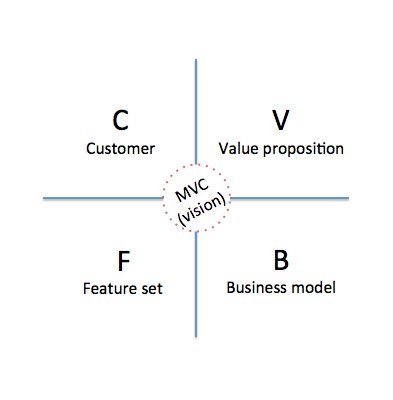A simple way to develop and pitch your next company
I work on lots of new ideas for companies. I have developed the following tool that helps me (and it seems many others) to quickly develop and evaluate these ideas.In the simplest form, it helps create an elevator pitch, (e.g. for www.gist.com – We focus on relationship centric professionals like sales, PR and recruiters (C) and, save them time (V) as they prepare for meetings, by creating dynamic full-contact dossiers (F) and charge them a monthly service fee (B). It is not critical for this to be the marketing pitch, but it helps.
To get started on finding the “MVC” (minimum viable company), you need to start with the “smallest idea that is big enough” (a few customers, 1 value, 1 key feature and a clear biz model). You need to identify real people you know (we built Gist for me and 2 sales guys, thx Kendall and Brandt) who can validate the idea, value, key features and their willingness to pay (which should be very high). As you find representative people, you can abstract key attributes of them to start to generalize into “personas” which becomes your real target customer. And from here you can start looking for the best beta users (more on that here) You can then compare different parts of the model to see how well the idea works. A few examples; C–V – does your target customer value what you are doing (e.g. saving time, qualifying leads, increasing revenue…) and how much (scale of 1-10)? Is the value a real pain or just nice to have? How do they solve this pain now? How would they quantify value? V–B – is the value your delivering correlated to the business model? If you save someone time, do you charge more depending on the amount of time you are saving? Work hard to correlate these things by changing one of the other. This ends up relating to ROI (return on investment). F–B – are the features you are building organized to support the different price points? C–B – does your customer usually buy in the model you are proposing? What other services/products do they buy that are similar to yours and is the model similar for these products? How much do they pay for related services? F–V – are the features you are building aligned with the value and in similar priority order? If your value is saving time, do you consider each feature on how much time it can save the end user? If you can’t make an idea work on a just a few users, just a few features, a pretty clear value prop and a clear business value, it’s probably not such a good idea. I know one tool does not solve all the issues in considering a new idea, but this is the best one I have found. Please suggest others and/or other ways this could be improved. Good luck on your next idea.
http://tamccann.com/developing-your-next-company-with-one-simple-tool/
By T.A. McCann
